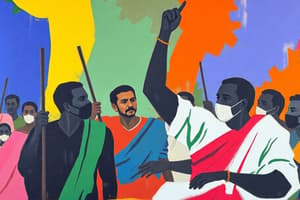Podcast
Questions and Answers
Who among the following social reformers focused on the emancipation of the downtrodden, marginalized communities, including women and Dalits?
Who among the following social reformers focused on the emancipation of the downtrodden, marginalized communities, including women and Dalits?
- Raja Ram Mohan Roy
- Ishwar Chandra Vidyasagar (correct)
- Mohammad Ali Jinnah
- Vidyasagar
What was the primary aim of the Satyashodhak Samaj founded by Jyotirao Phule?
What was the primary aim of the Satyashodhak Samaj founded by Jyotirao Phule?
- Challenge social injustices (correct)
- Support British colonial rule
- Advocate for gender inequality
- Promote caste-based hierarchies
Why did the British Government partition the Bengal Presidency in 1905?
Why did the British Government partition the Bengal Presidency in 1905?
- To appease Muslim elites who felt underrepresented (correct)
- To promote unity among Hindu and Muslim nationalists
- To increase trade relations with foreign countries
- To encourage the Swadeshi movement
What was the main goal of the Swadeshi Movement initiated in response to the partition of Bengal?
What was the main goal of the Swadeshi Movement initiated in response to the partition of Bengal?
Which prominent figure emerged as Indian Muslim leadership following the partition of Bengal?
Which prominent figure emerged as Indian Muslim leadership following the partition of Bengal?
What were some consequences of the partition of Bengal for the Indian subcontinent?
What were some consequences of the partition of Bengal for the Indian subcontinent?
Who is often credited with launching the modern Indian renaissance?
Who is often credited with launching the modern Indian renaissance?
Which social reformer played a pivotal role in initiating the abolition of the practice of sati?
Which social reformer played a pivotal role in initiating the abolition of the practice of sati?
What was one of Ishwar Chandra Vidyasagar's notable contributions to social reform?
What was one of Ishwar Chandra Vidyasagar's notable contributions to social reform?
Which movement within Hinduism sought to purge the religion of superstition and idolatry?
Which movement within Hinduism sought to purge the religion of superstition and idolatry?
In which century did India witness a surge of social activism and reform efforts?
In which century did India witness a surge of social activism and reform efforts?
Who introduced the Widow Remarriage Act as part of Hindu marriage law reforms?
Who introduced the Widow Remarriage Act as part of Hindu marriage law reforms?
Flashcards are hidden until you start studying
Study Notes
Indian History of the 19th Century: Social Reforms and the Partition of Bengal
In the 19th century, India underwent significant transformations, both in the political landscape and in the realm of social reform. As the British Raj consolidated its rule, a growing number of Indians sought to address long-standing inequalities and injustices in their society. Two particularly notable developments of this era were the social reform movements and the infamous Partition of Bengal.
Social Reforms Movements
The 19th century witnessed a surge of social activism and reform efforts aimed at improving the lives of India's marginalized communities. Prominent figures such as Raja Ram Mohan Roy, Ishwar Chandra Vidyasagar, and Jyotirao Phule, among others, championed causes to empower women, abolish child marriage, and eradicate the practice of sati (widow immolation).
Raja Ram Mohan Roy (1772-1833) is often credited with launching the modern Indian renaissance through his unwavering advocacy for religious tolerance and social equality. He founded the Brahmo Samaj, a reformist movement within Hinduism that sought to purge the religion of superstition and idolatry. Roy also played a pivotal role in initiating the abolition of the practice of sati.
Ishwar Chandra Vidyasagar (1820-1891) was a prominent educationist and social reformer. His efforts to reform Hindu marriage law included the introduction of the Widow Remarriage Act, which granted greater rights and freedoms to widows. Vidyasagar's work helped to challenge prevailing patriarchal norms and brought about significant changes in the lives of Indian women.
Jyotirao Phule (1827-1890) was a social reformer who focused on the emancipation of the downtrodden and marginalized communities, including women and Dalits (formerly known as Untouchables). Phule founded the Satyashodhak Samaj, a social reform movement that aimed to challenge caste-based hierarchies and promote social justice.
Partition of Bengal
In 1905, the British Government partitioned the Bengal Presidency, creating two separate provinces: Eastern Bengal and Assam, and Western Bengal. The partition was primarily a political move designed to appease the Muslim elites, who felt underrepresented in the larger province.
The partition sparked intense opposition and resistance from both Hindu and Muslim nationalists, who saw it as a divisive and ill-conceived policy. The Indian National Congress, the preeminent political party of the era, spearheaded the Swadeshi Movement as a response to the partition. The Swadeshi movement promoted self-reliance and the boycott of foreign goods, including British goods, in an effort to pressure the British Government to rescind the partition.
The partition of Bengal also led to the rise of Indian Muslim leadership, including the prominent figure Mohammad Ali Jinnah, who would later go on to become the founder of Pakistan. The partition exposed deep-seated tensions between Hindu and Muslim communities, which would contribute to the partition of British India in 1947.
The 19th century in India was marked by a period of transformative change, as social injustices were challenged, and new ideas of social equality were promoted. The efforts of social reformers such as Raja Ram Mohan Roy, Ishwar Chandra Vidyasagar, and Jyotirao Phule, among others, played a crucial role in shaping a more just and equitable society. The partition of Bengal, while a politically motivated decision, also had far-reaching consequences for the Indian subcontinent, ultimately contributing to the partition of British India.
Studying That Suits You
Use AI to generate personalized quizzes and flashcards to suit your learning preferences.




